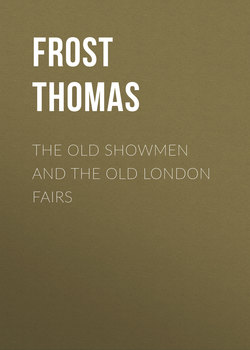The Old Showmen and the Old London Fairs

Реклама. ООО «ЛитРес», ИНН: 7719571260.
Оглавление
Frost Thomas. The Old Showmen and the Old London Fairs
PREFACE
CHAPTER I
CHAPTER II
CHAPTER III
CHAPTER IV
CHAPTER V
CHAPTER VI
CHAPTER VII
CHAPTER VIII
CHAPTER IX
CHAPTER X
CHAPTER XI
Отрывок из книги
There can be no doubt that the practice of holding annual fairs for the sale of various descriptions of merchandise is of very great antiquity. The necessity of periodical gatherings at certain places for the interchange of the various products of industry must have been felt as soon as our ancestors became sufficiently advanced in civilisation to desire articles which were not produced in every locality, and for which, owing to the sparseness of the scattered population, there was not a demand in any single town that would furnish the producers with an adequate inducement to limit their business to one place. Most kinds of agricultural produce might be conveyed to the markets held every week in all the towns, and there disposed of; but there were some commodities, such as wool, for example, the entire production of which was confined to one period of the year, while the demand for many descriptions of manufactured goods in any one locality was not sufficient to enable a dealer in them to obtain a livelihood, unless he carried his wares from one town to another. What, therefore, the great fair of Nishnei-Novgorod is at the present day, the annual fairs of the English towns were, on a less extensive scale, during the middle ages.
One of the most ancient, as well as the most important, of the fairs of this country was that held on St. Giles’s Hill, near Winchester. It was chartered by William I., who granted the tolls to his cousin, William Walkelyn, Bishop of Winchester. Its duration was originally limited to one day, but William II. extended it to three days, Henry I. to eight, Stephen to fourteen, and Henry II. (according to Milner, or Henry III., as some authorities say) to sixteen. Portions of the tolls were, subsequently to the date of the first charter, assigned to the priory of St. Swithin, the abbey of Hyde, and the hospital of St. Mary Magdalene. On the eve of the festival of St. Giles, on which day the fair commenced, the mayor and bailiffs of Winchester surrendered the keys of the four gates of the city, and with them their privileges, to the officers of the Bishop; and a court called the Pavilion, composed of the Bishop’s justiciaries, was invested with authority to try all causes during the fair. The jurisdiction of this court extended seven miles in every direction from St. Giles’s Hill, and collectors were placed at all the avenues to the fair to gather the tolls upon the merchandise taken there for sale. All wares offered for sale within this circle, except in the fair, were forfeit to the Bishop; all the shops in the city were closed, and no business was transacted within the prescribed limits, otherwise than in the fair. It is probable, however, that most of the shopkeepers had stalls on the fair ground.
.....
This extraordinary creature must have been more than twenty years of age when Evelyn saw her, for the engraved portrait described by Granger bears the following inscription: – “Barbara Vanbeck, wife to Michael Vanbeck, born at Augsburg, in High Germany; daughter of Balthasar and Anne Ursler. Aged 29. A.D. 1651. R. Gaywood f. London.”
Another engraved portrait, in the collection of the Earl of Bute, represents her playing the harpsichord, and has a Dutch inscription, with the words – “Isaac Brunn delin. et sc. 1653.” One of Gaywood’s prints, which, in Granger’s time, was in the possession of Fredericks, the bookseller, at Bath, had the following memorandum written under the inscription: – “This woman I saw in Ratcliffe Highway in 1668, and was satisfied she was a woman. John Bulfinch.” Granger describes her from the portraits, as follows: – “The face and hands of this woman are represented hairy all over. Her aspect resembles that of a monkey. She has a very long and large spreading beard, the hair of which hangs loose and flowing like the hair of the head. She is playing on the organ. Vanbeck married this frightful creature on purpose to carry her about for a show.”
.....